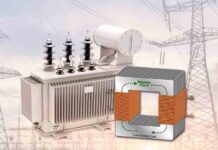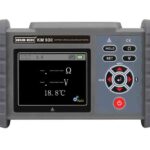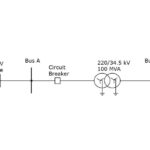
True 3-Phase Testing Makes Difference in Power Transformer Diagnostics
Power transformers are critical components in an electrical power network. Testing, diagnostics and reliable condition assessment of power transformers becomes increasingly relevant due to the aging of transformer fleets around the globe. Performing a range of standard electrical tests on a regular basis has proven to be an effective way of gaining reliable insight into the operating condition of transformers. But, this has been a time- and cost-intensive job in the past. Different equipment needed to be used for each test, each phase had to be measured individually and the connections had to be changed between the tests. A true three phase test system can really make a difference.

“TESTRANO 600 makes power transformer testing three times faster than with conventional single phase test devices.
One system – Multiple Tests
TESTRANO 600 is the only portable, three-phase test system which combines the most common electrical tests on power transformers for routine and diagnostic testing on site or during factory acceptance tests (FAT) in one system:
• 3-phase winding resistance with 33 A
• 3-phase transformer turns ratio with 400 V L-L
• 3-phase short-circuit impedance / leakage reactance
• Exciting current
• Frequency response of stray losses (FRSL) at 15 Hz – 400 Hz
• Dynamic resistance measurement
• Power / dissipation factor measurements at 15Hz –400 Hz
• Fast demagnetization with up to 30 A
DC Winding Resistance Measurement
DC winding resistance measurements are used to determine continuity problems in the winding connections and tap changer contacts. They are also used to check the on-load tap changer (OLTC) as they can indicate when to clean or replace OLTC contacts, or when to replace or refurbish the OLTC itself. Failures can be detected without opening the tap changer compartment. During the measurement the resistance of each subsequent tap position is investigated and compared with the reference measurement data of the manufacturer. Using TESTRANO 600 you can measure e.g. all three-phases of a wye-connected winding simultaneously. This makes testing three times faster than single-phase testing and reduces your average measurement time.
During DC winding resistance measurements the core of the transformer may be magnetized. Therefore, it is recommended to demagnetize the core after performing this test.
Transformer Turns Ratio (TTR) Measurement
Transformer turns ratio (TTR) measurements are performed to verify the fundamental operating principle of a power transformer. By measuring the ratio and phase angle from one winding to the other, open circuits and shorted turns can be detected. The turns ratio is determined during factory acceptance tests (FAT) and needs to be checked routinely once the transformer is in service. TTR measurements can also be triggered by a tripped relay and other diagnostic tests like dissolved gas analysis
(DGA) and dissipation factor/power factor measurements. The results of a TTR measurement are compared with nameplate values and across phases. When performing a TTR measurement with TESTRANO 600 a true 3 phase voltage signal with 120° phase shift of up to 400 V L-L is applied to the primary side of the transformer which is measured back on the secondary side. With this true three phase method the ratio and phase shift of any winding configuration can be verified. This comes in very handy, especially when measuring phase shifting or rectifier units with unconventional vector groups. Another advantage of this technique is that the connection for all vector groups is the same, making it very easy to perform the measurement and leaving almost no room for error.
A magnetized core or missing ground reference may influence the measurement and lead to incorrect results. Making sure the transformer core is demagnetized and proper grounds are established on each winding is therefore very important.
Short-Circuit Impedance / Leakage Reactance Measurement
Short-circuit impedance / leakage reactance measurements are sensitive methods for assessing the potential deformation or displacement of windings. Severe short-circuits or transportation of the power transformer may cause the windings to move or become deformed. In events like these, short-circuit impedance / leakage reactance tests are recommended. The tests are usually performed as a three-phase measurement which can be compared to the nameplate value established by the manufacturer during factory acceptance tests. As this value represents the average across all three phases, a per-phase measurement is also recommended for winding diagnosis.
With TESTRANO 600, you can test all three-phases in parallel. This saves time and reduces the number of trips up the ladder.

“No need for a laptop: TESTRANO TouchControl on the 10.6 multi-colour displays allows fast and easy on-site testing.”
Exciting Current Measurement
Exciting current measurements are performed to assess the turn-to-turn insulation of the windings, the magnetic circuit of a transformer as well as the tap changer. The most valued benefit of the test is to detect turn-to-turn short-circuits in a winding. Physical movement of the core laminations severe damage of the core can influence the reluctance and, thus, will result in a change in exciting current. Deviations may also indicate contact wear or improper wiring of the tap changer. The exciting currents of all three phases can be determined while measuring turns ratio with the TESTRANO 600. For an exciting current measurement at 10 kV, the TESTRANO 600 can be combined with the CP TD1.
Frequency Response of Stray Losses (FRSL) Measurement
The frequency response of stray losses (FRSL) test is a measurement of the resistive component of the short-circuit impedances at multiple frequencies. It is the only electrical method to identify short-circuits between parallel strands and local overheating due to excessive eddy current losses. Similar to the short-circuit and leakage reactance test, it is recommended to perform the FRSL measurement as a commissioning or acceptance test to establish benchmark results. Likewise FRSL tests are not routine diagnostic tests, but are recommended for advanced diagnostics.
With TESTRANO 600 the measurement can be done across a frequency range of 15 Hz to 400 Hz on all three phases at the same time without any reconnecting. This advanced diagnostic test and the short-circuit impedance / leakage reactance test can be done simultaneously, because the test setup is the same.
The analysis of FRSL results is largely visual and includes the comparison across phases and over time. An increase in impedance over the frequency range can be observed as the eddy losses become more pronounced at higher frequencies. This increase should be uniform across all three phases and problems are usually indicated by phase deviations at the upper end of the frequency spectrum.
Dynamic Resistance Measurement (DRM)
DRM is used to check the on-load tap changer (OLTC) for poorly maintained and damaged OLTC contacts. It is performed as a supplementary measurement in order to analyze the transient switching process of resistive type diverter switches. When switching the tap changer during winding resistance measurements, the DC current temporarily decreases due to the additional commutating resistors of the diverter switch. This current signature is recorded and can be analyzed to identify contact and timing problems of the tap changer.
A fast and comprehensive analysis of the switching process and the internal contacts of tap changers with resistive type diverter switches can be perform with TESTRANO 600. The measurement can be done in parallel to the DC winding resistance tests.
Power or Dissipation Factor (PF/DF) & Capacitance Measurement
PF/DF and capacitance measurements are performed in order to investigate the insulation condition of power transformers and bushings. Both insulation systems are essential for the reliable operation of the transformer. High oil conductivity, aging and an increase in the water content are symptoms of the degradation process in the insulation. These symptoms also result in an increase of losses, which can be quantified by measuring the power factor or dissipation factor. Changes in capacitance can indicate partial breakdown between the capacitive layers of bushings. By measuring the capacitance and losses, problems in the insulation can be detected before a failure occurs.
Standard PF/DF measurements at 50 Hz or 60 Hz can only detect the effects of moisture and aging at an advanced stage. Using frequencies other than line frequency increases the sensitivity of the measurement as some problems are more dominant at frequencies above or below line frequency. Combining the TESTRANO 600 with the CP TD1 accessory, allows you to measure PF/DF across a wide frequency range of 15 Hz to 400 Hz and detect defects at an earlier stage.

“One test-setup with 3 multi-plug cables can be used to perform multiple tests on power transformers.”
Active Discharge & Fast Demagnetization
The active discharge function (patent pending) of TESTRANO 600 automatically discharges the winding within a matter of seconds after resistance measurements have been performed. This guarantees a high level of safety during testing and reduces testing time. You can also demagnetize the transformer’s core before and after performing a reliable test with TESTRANO 600. This reduces the risk of high inrush currents and avoids the influence of a magnetized core on subsequent tests, such as excitation current tests or sweep frequency response analysis.
Three Wires Are All You Need
By using TESTRANO 600 you can perform various tests without rewiring.
Specially designed multi-purpose cables are used to connect TESTRANO 600 to the high-voltage and low-voltage side of the transformer. The cables, which support a 4-wire (Kelvin) connection, have to be connected to the transformer’s terminals once. Afterwards, all test outputs and measurement inputs are automatically controlled by TESTRANO 600 without the need to change the connection again. An additional multi-plug cable can be connected to switch between different tap positions of an on-load tap changer (OLTC) automatically. This cable can also be used to record motor current and voltage of the OLTC.
The custom-designed connector plugs and labelled connection leads leave an extremely narrow margin for wiring errors. Thus, tangled cables become a thing of the past and it is easy for you to maintain an overview of the connections.
Additionally, there is no need for an additional external switchbox when testing with TESTRANO 600. Users of conventional single phase testing devices have to connect a switchbox to test all 3 phases in parallel and accept compromises in terms of usability. The unique approach of TESTRANO 600 with its three internal sources offer true three phase testing with just one portable unit.
Rugged, Compact & Safe
Despite its extensive range of functions, the TESTRANO 600 weighs only 20 kg/44 lbs. The rugged design makes it ideal for on-site testing even in rough environments. When combined with the CP TD1 for power/dissipation factor measurement, both devices can be mounted on a trolley, which makes them easy to transport. In order to ensure safety during testing, TESTRANO 600 is equipped with an emergency stop button as well as safety and warning lights.
TESTRANO can be operated it via the smart TESTRANO TouchControl on the integrated touch display or via the Primary Testing Manager™ (PTM) software on your laptop. This makes it ideal for routine and diagnostic testing on site or during factory acceptance tests (FAT).
Touch-and-Test
TESTRANO TouchControl on the integrated touch display offers pre-configured wiring diagrams and convenient features for graphical comparisons and detailed analysis. You can prepare tests in advance and import the test files via the USB interface. In order to identify your asset and keep your test results organized, you can enter basic transformer nameplate information before starting your test.
The high contrast of the high-resolution, multi-touch 10.6” display ensures good visibility even in bright sunlight. This allows fast, flexible and easy testing on site – just touch & test.
For More Guidance in Testing
Using TESTRANO 600 with the PTM software offers you full guidance while testing and easy data management. It enables you to control and operate the connected test set directly from your laptop. Detailed wiring diagrams and asset-specific test plans based on international standards will support you in executing your tests. For a comprehensive analysis, PTM offers automatic result assessment and comparison as well as customized reporting.
Additionally, PTM provides a well-structured database for managing all related transformer data to get a comprehensive overview of your asset’s condition. You can define and manage locations, assets, jobs and reports in an easy and fast way.
A True Cost & Time Saver
At a time, when testing and condition assessment of power transformers becomes more relevant a true three phase test system can really make the difference. The cost and time savings achieved with a three phase test system are tremendous, especially when testing on-site.

If you want to share thoughts or feedback then please leave a comment below.




















The best kit for time optimized diagnostic tests on Power transformer in a single shot.